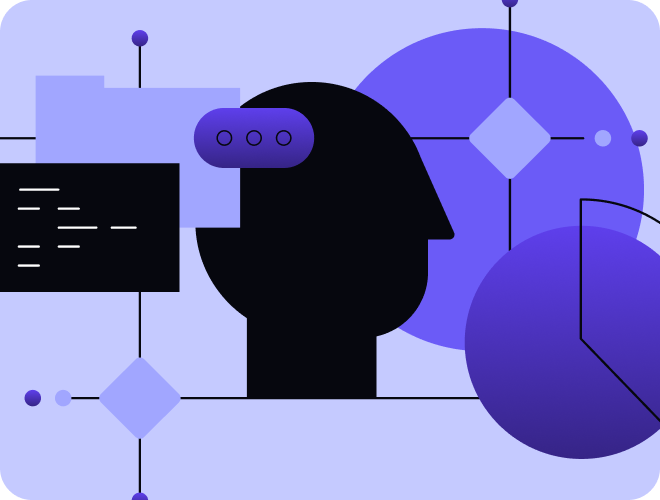What is Generative AI? All to Know
.avif)

Do you have a project in mind?


Generative AI has moved from a trendy term to a business tool.
Behind today’s content engines, design tools, and developer assistants are models trained to generate output that resembles, sounds like, or functions like something a human created.
However, understanding what it is and what it isn’t is required for any company considering adoption.
This blog explains how generative AI models work, what makes them valuable, their role in a business setting, and the limitations that still remain.
If your team is exploring ways to speed up production, support creativity, or personalize user experience, this guide will help you understand what’s possible with today’s tools.
What is Generative AI?
Generative AI refers to a category of artificial intelligence designed to create content: text, images, audio, or code, based on patterns it has learned from data. Instead of returning fixed outputs, it generates new results each time, tailored to the input it receives.
These systems rely on machine learning models, particularly deep learning architectures like generative adversarial networks (GANs), diffusion models, and large language models (LLMs).
Each uses different methods to understand context, process unlabeled data, and create something new, from realistic images to long-form writing.
What sets generative models apart is their flexibility. They can:
- Write articles or support replies
- Create design assets or marketing visuals
- Simulate voices or generate training data
- Support software development and testing
How Does Generative AI Work?

Generative AI systems work by identifying patterns in large volumes of data, then using those patterns to create entirely new content. This process is driven by machine learning models that learn from examples rather than rules.
Most generative AI models are deep learning techniques like transformers, recurrent neural networks, or diffusion models.
These are trained on raw data, such as articles, images, audio clips, or code. The system is exposed to massive data samples, often including both labeled data and unlabeled data, to recognize how content is structured.
During training, the model learns to:
- Predict the next word, pixel, or data point
- Reconstruct missing pieces of input
- Generate context-aware sequences based on prompts
The most widely used foundation models, such as large language models for text or Stable Diffusion for visual content, can support multiple tasks without requiring retraining for each one.
Some models also incorporate retrieval-augmented generation (RAG), which allows them to pull from external sources during response generation.
Key components of the workflow include:
- Training data: Used to teach the model structure and context
- Model architecture: Determines how the system processes inputs
- Prompt input: Guides what the output should resemble
- Sampling and refinement: Ensures the final result is coherent and relevant
As these AI applications grow more common, especially in content creation and customer service chatbots, developers are refining them to work with enterprise data, support structured data formats, and generate results tailored to business needs.
Types of Generative AI Models

Generative AI includes several model types, each designed to learn from training data and produce new outputs based on what it’s learned. These generative models support a range of applications, from text generation to image creation, and continue to grow as new machine learning algorithms emerge.
Below are the most widely used types of generative AI models, along with how each contributes to different AI applications:
- Large Language Models (LLMs): These are trained to generate text, answer questions, or summarize long documents using natural language processing. LLMs like GPT and Claude rely on vast amounts of structured and unstructured data to support tools for writing, chat, and content creation.
- Diffusion Models: Used in image generation, these models gradually turn noise into detailed visuals. Tools based on diffusion models, such as Stable Diffusion, can create realistic images or visual assets from short prompts. They are also being explored in video generation and 3D modeling.
- Generative Adversarial Networks (GANs): GANs consist of two competing neural networks, one that generates content and another that critiques it. This enables the creation of photorealistic images, synthetic data, and media for design or simulation environments.
- Variational Autoencoders (VAEs) are designed to learn efficient data representations and are often used for tasks involving complex data, such as music generation, speech generation, and generative AI applications that require structure and variation.
- Recurrent Neural Networks (RNNs): Although used less frequently today, RNNs played a key role in early text generation and language models. They are still applied in tasks involving sequences, such as time-series predictions and structured dialogue.
- Retrieval-Augmented Generation (RAG): This hybrid architecture blends foundation models with external databases or sources. It enables generative AI systems to access up-to-date information in real-time, resulting in more accurate and grounded outputs within factual contexts. If you're wondering how to implement RAG, check out this blog.
Each of these AI models has strengths in different areas of generation. Many current tools combine several models to support multiple tasks, improve performance, and ensure the output matches real-world demands.
How Successful Generative AI Applications Look Like?
The most effective generative AI applications solve specific problems with consistent, reliable output. They’re built to reduce effort, save time, or improve precision in real workflows.
Successful implementations share several traits:
- Clear objectives: Whether it’s summarizing text, assisting developers, or creating visuals, strong use cases focus on a task the model can handle repeatedly and accurately.
- Aligned data: The best results are achieved when generative AI models are trained or fine-tuned using their own data or labeled data that closely mirrors the actual task environment.
- Tight feedback loops: Models that learn from user input, apply corrections, or respond to context perform better over time. This is especially true in systems using deep learning or foundation models embedded in user-facing platforms.
- Well-scoped generation: Instead of generating open-ended responses, successful tools are built around structured outputs. For instance, generative AI tools that create support ticket replies, marketing briefs, or compliance reports all follow a controlled pattern.
- Responsible integration: These systems are deployed alongside AI agents or user interfaces that guide interaction. When the output is editable, reviewable, or traceable, adoption increases, and risk decreases.
In practice, these applications are used to:
- Prepare legal templates or onboarding documents
- Power gen AI tools for image generation or ad creatives
- Enable text generation inside CRMs or helpdesk software
- Generate variations of existing assets for testing and distribution
Use Cases for Generative AI in Business

Content Creation for Blogs, Ads, & Social Media
Marketing teams are using generative AI to speed up content writing across formats.
With language models trained on a range of tone, topic, and structure patterns, teams now draft outlines, captions, and ad copy in minutes.
The most effective tools in this space are:
- ChatGPT: Good for long-form copy, outlines, and prompt-driven writing
- Jasper: Focused on brand voice and advertising variants
- Copy.ai: Useful for short copy and social snippets
What makes these tools useful it’s the ability to shape messaging around strategy without starting from zero. Teams still review and revise, but the groundwork is done faster.
Product Mockups and Design Prototyping
For early creative work, teams often use generative AI models to produce initial visuals. These systems support tasks like UI layout sketches, landing page concepts, or image variants for testing.
Designers use:
- Midjourney for stylized visuals or concept art
- Figma’s AI extensions for quick layout adjustments
- RunwayML to test animations or asset combinations
Instead of creating from a blank canvas, these tools offer starting points. That helps teams work through more ideas before committing to a direction, improving early-stage collaboration.
Code Generation & Developer Acceleration
Developers use generative AI to reduce repetitive work, review logic, and draft code faster.
Instead of building entire programs, these tools support smaller tasks, refactoring functions, generating snippets, or suggesting changes based on surrounding syntax.
This approach improves speed during early coding stages and helps spot issues before they reach production. Teams still lead the process, but AI steps in as a support layer.
Tools that work well here include:
- GitHub Copilot for suggesting code in real time
- Amazon CodeWhisperer for completing and correcting logic
- Tabnine for lightweight integrations and IDE suggestions
Each tool relies on large language models trained on open-source examples.
These models identify patterns, fill gaps, and reduce mental load, especially helpful during long sessions or when building from templates.
Virtual Assistants & Customer Messaging Tools
In support and sales, generative AI models help teams respond faster without sounding generic.
Assistants powered by foundation models draft replies, summarize requests, or adjust responses based on input tone and length.
This use case depends on context. Some teams apply these systems to first replies, while others let AI handle follow-ups or internal notes. Either way, they improve volume handling and maintain quality across channels.
Tools used include:
- Ada for automated conversations with flexible branching
- Intercom Fin for smart replies and suggested answers
- Forethought for triaging and drafting support messages
These platforms rely on deep generative models that pull from previous models, used to train on broad datasets. The systems improve with usage, learning over time what matters most in each interaction.
Document Summarization & Knowledge Management
Many teams deal with high volumes of unstructured text, meeting transcripts, legal documents, or technical manuals. Generative AI helps reduce that workload by turning raw input into short, structured summaries.
Instead of reading full reports, users get context in seconds. That makes information easier to absorb, search, and share.
Reliable tools for this use case include:
- Claude for tone-aware summaries of long-form text
- Scribe for summarizing meetings and internal documentation
- Notion AI for converting messy notes into clear action points
Each tool uses foundation models trained on diverse formats, allowing them to handle both technical and conversational input.
Personalization at Scale in Marketing & Sales
Modern outreach relies on context.
Generative AI models enable marketers and sales teams to tailor content based on industry, persona, or behavior, thereby eliminating the need to draft each message manually.
Instead of copying the same email to hundreds of leads, teams use gen AI tools to write unique intros, adapt messaging to each segment, or recommend product options that align with user profiles. It’s not just faster, it performs better.
Effective tools in this area include:
- Mutiny for personalizing web experiences by visitor type
- Lavender for drafting custom sales emails based on CRM fields
- Copy.ai Workflows for generating outreach in bulk, mapped to account data
AI models power these tools trained to match tone, identify common objections, and produce copy that sounds written, not pasted. Each draft originates from models trained on actual buyer data, not random internet samples.
With generative artificial intelligence, what once took hours now takes minutes, and the output is more relevant from the start.
Benefits of Generative AI for Modern Teams
Speeds Up Production Across Content & Code
Generative AI gives teams a head start, whether they’re writing, coding, or designing. It handles repetitive groundwork and gets drafts moving faster. Writers skip the blank page.
Developers skip boilerplate. Designers test more variations before committing.
The advantage isn’t just about speed. It’s about saving cognitive effort for decisions that matter. By using AI models to produce first versions or review existing work, teams move through more output with less friction.
Teams using generative AI tools see real impact in areas like:
- Blog and ad copy
- Email scripting
- Code refactoring
- Design mockups
Instead of starting from zero, teams get a base they can refine, cutting production timelines without losing quality.
Scales Output Without Growing Headcount
When volume increases, most teams face a choice: either add staff or reduce output. Generative AI offers a third option.
It helps teams expand reach, maintain frequency, and personalize at scale, without increasing the number of people behind it.
This is especially useful in areas where variation matters, such as sales outreach, customer responses, or multilingual content. Generative AI models can produce dozens of drafts based on predefined variables, providing teams with flexibility without added overhead.
Common applications include:
- Personalized messaging for marketing
- Response templates in customer support
- Code suggestions in product teams
Lowers the Cost of Prototypes & Drafts
Creating early-stage work typically requires time, specialized tools, and a budget. Generative AI changes that. It provides teams with a way to test ideas, whether it’s a concept sketch, UI wireframe, or blog outline, without involving multiple people or agencies.
Teams use generative AI tools to simulate designs, test voice, or map layout options.
The results don’t replace professionals, but they give stakeholders something to react to earlier in the process.
This saves money by reducing back-and-forth and shortening timelines between idea and decision. For small teams or early-stage projects, that flexibility is especially valuable.
Supports Teams with On-Demand Creative Help
When deadlines pile up, even strong teams hit a wall.
Generative AI offers a way to push past bottlenecks, generating first drafts, offering rewrites, or suggesting structure in moments when the team stalls.
It’s not about replacing roles. It’s about reducing wait times and providing a quick starting point for people. With generative AI models trained on thousands of patterns, the systems can fill in blanks or handle smaller parts of a larger project.
Designers, writers, and developers use these tools to:
- Brainstorm ideas
- Rework content
- Structure outlines or scripts
By offering fast support at key points, AI systems keep creative output moving when momentum dips.
Creates Personalized Learning
Not every team member learns the same way—or at the same speed. Generative AI helps bridge that gap by delivering tailored explanations, follow-ups, or examples based on user feedback.
Instead of one-size-fits-all documentation or static walkthroughs, teams can create adaptive content that adjusts to skill level, role, or task. This is especially useful in onboarding, internal training, or product demos.
Tools built on foundation models can now:
- Rephrase instructions
- Simulate practice scenarios
- Offer context-specific suggestions
The result is faster learning, more confident execution, and fewer follow-up questions across the board.
What Are the Limitations of Generative AI?
While generative AI offers speed and scale, it is not without its gaps.
These tools perform well in structured settings, but their limitations become more visible in high-stakes, ambiguous, or highly regulated environments.
The most common constraints include:
- Inaccuracy and hallucination: Some generative AI models confidently return results that sound correct but aren’t grounded in fact. This is especially risky in legal, healthcare, or financial content, where incorrect details can create problems quickly.
- Lack of context awareness: Many AI systems still struggle with nuance, tone shifts, or information that changes frequently. Without updated context or real-time awareness, outputs can sound outdated or off-mark.
- Training data bias: Models reflect the data they’re trained on. If the training data carries bias, that bias shows up in the output, impacting fairness, inclusivity, or tone accuracy.
- Limited memory and control: In longer sessions or multi-step tasks, even the best foundation models can lose track of prior messages or generate repetitive content.
- Generic outputs: Without careful prompt tuning or post-editing, content often feels flat or vague. Generative AI systems aren’t creative on their own, they echo structure based on prior examples.
- Security and IP concerns: Using AI to generate content from internal or enterprise data raises questions about confidentiality, ownership rights, and how outputs should be handled or credited.
NerdHeadz Builds Generative AI For Companies Like Yours
You don’t need to guess how generative AI fits into your business. At NerdHeadz, a custom software development agency, we work with companies that want tailored, usable systems, not just off-the-shelf software.
Whether it’s a chatbot that drafts replies using internal knowledge, a content engine that adjusts for voice and tone, or a prototype builder that generates UI ideas in seconds, our team builds for real workflows, not one-size-fits-all demos.
We’ve delivered:
- Language models customized to brand voice
- Generative features inside dashboards, portals, and CRMs
- Content tools trained on company-specific materials
- Internal tools to automate writing, analysis, or customer messaging
What sets us apart is how we scope and build.
Every project is aligned with your teams, your data, and your workflow, not someone else’s playbook. We guide the entire process: from discovery and prototyping to deployment and iteration, using clear steps and measurable outcomes.
If your team is ready to do more with generative AI, we’ll help you make it practical, focused, and effective from day one.
Conclusion
Generative AI is transforming the way teams approach writing, coding, design, and communication.
When used effectively, it reduces bottlenecks, extends creative bandwidth, and makes high-volume output more manageable without requiring additional headcount.
But the tools alone don’t create results.
Success depends on having the right models, applied to the right workflows, with the right oversight in place. That’s why companies are turning to AI development partners who understand how to build for function, not just trend.
If your company is ready to build with generative AI, get in touch with NerdHeadz, we’ll help you turn possibility into product.
Frequently asked questions
What is a generative AI example?
A common example of generative AI is ChatGPT. It generates text based on prompts, often used for writing, summarizing, or answering questions.
What is the difference between generative and agentic AI?
Generative AI creates content. Agentic AI goes further, it plans, takes action, and completes tasks across systems with minimal input.
Is ChatGPT a generative AI?
Yes. ChatGPT is a generative AI model designed to produce text based on user input, not to take independent actions.
Is Siri a generative AI?
No. Siri is a voice assistant powered by predefined rules and retrieval-based systems. It doesn’t generate original responses like generative AI models do.

%201.svg)

%201%20(1).svg)
.svg)
%201%20(1).svg)

%201.svg)
_%20All%20to%20Know.png)



.png)
%201.svg)
.svg)
%201.svg)
